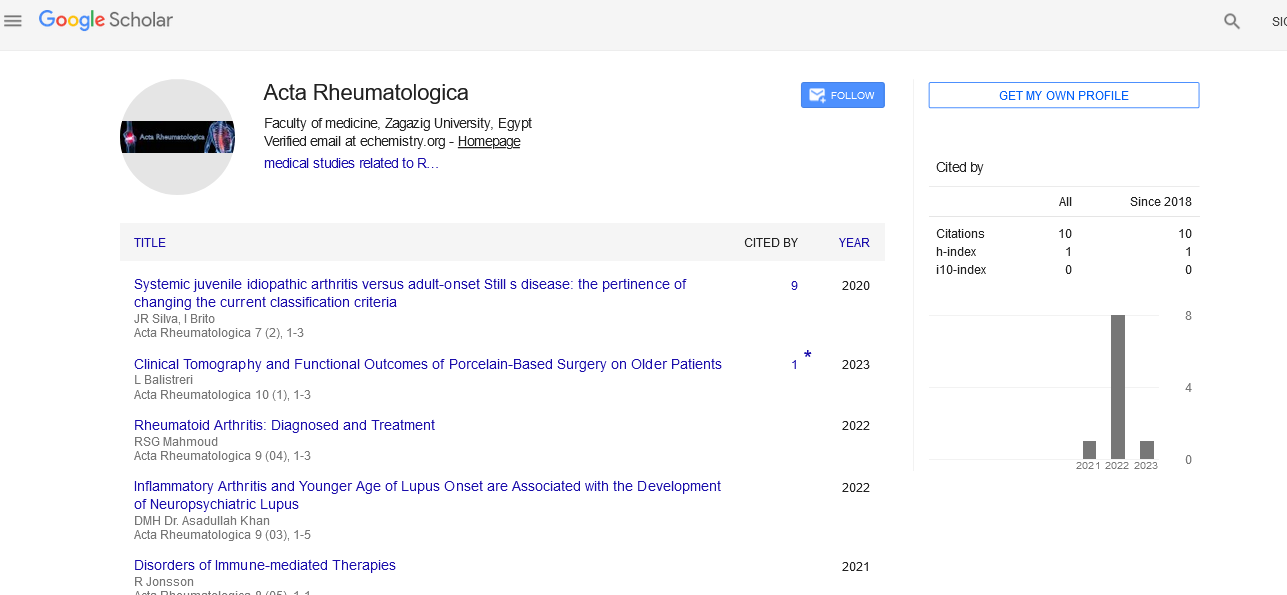Perspective - (2024) Volume 11, Issue 3
Beyond the Joints: Navigating the Landscape of Joint Disorders
Laura C. Coates*
Department of Rheumatology, University of Thessaly, Volos, Greece
*Correspondence:
Laura C. Coates, Department of Rheumatology, University of Thessaly, Volos,
Greece,
Email:
Received: 07-May-2024, Manuscript No. IPAR-24-14798;
Editor assigned: 10-May-2024, Pre QC No. IPAR-24-14798 (PQ);
Reviewed: 24-May-2024, QC No. IPAR-24-14798;
Revised: 04-Jun-2024, Manuscript No. IPAR-24-14798 (R);
Published:
11-Jun-2024
Introduction
Joint disorders encompass a spectrum of debilitating
conditions that affect millions worldwide, compromising
mobility, function, and quality of life. From the wear and tear of
osteoarthritis to the relentless inflammation of rheumatoid
arthritis, these disorders manifest diverse pathologies, posing
diagnostic and therapeutic challenges. In this article, we embark
on a comprehensive exploration of joint disorders, unraveling
their underlying mechanisms, diagnostic approaches, treatment
modalities, and avenues for ongoing research and innovation.
Joints serve as pivotal structures facilitating movement and
bearing mechanical loads, encompassing a diverse array of
articulations ranging from synovial joints, such as the knee and
shoulder, to fibrous and cartilaginous joints. Comprising bones,
cartilage, ligaments, tendons, and synovial fluid, joints undergo
dynamic biomechanical interactions that ensure smooth
articulation and distribution of forces. Disruptions in joint
integrity, whether due to injury, inflammation, or degeneration,
can precipitate the onset of joint disorders, heralding a cascade
of structural and functional abnormalities.
Description
Osteoarthritis: The wear and tear of aging joints
Osteoarthritis (OA) stands as the most prevalent joint
disorder, characterized by progressive degeneration of articular
cartilage, subchondral bone changes, and synovial inflammation.
Advanced age, obesity, joint trauma, and genetic predisposition
are among the myriad factors implicated in OA pathogenesis.
Clinically, OA manifests as joint pain, stiffness, swelling, and
diminished range of motion, leading to substantial disability and
impaired quality of life. While conventional management
strategies focus on pain relief, physical therapy, and lifestyle
modifications, emerging therapies targeting cartilage
regeneration and inflammation hold promise for altering the
disease course and preserving joint function.
Rheumatoid arthritis: Unveiling the complexities of
autoimmune joint disease
Rheumatoid Arthritis (RA) represents a prototypical
autoimmune disorder characterized by chronic synovial
inflammation, joint destruction, and systemic manifestations.
Autoantibodies, including rheumatoid factor and anticitrullinated
protein antibodies, play a central role in RA
pathogenesis, triggering aberrant immune responses against
self-antigens. The synovium, a dynamic tissue lining the joint
capsule, undergoes hyperplasia and infiltration by immune cells,
perpetuating local inflammation and cartilage erosion.
Treatment paradigms for RA have undergone a paradigm shift
with the advent of biologic agents targeting pro-inflammatory
cytokines and immune cells, offering unprecedented efficacy in
disease control and joint preservation.
Juvenile idiopathic arthritis: Navigating challenges in
pediatric rheumatology
Juvenile Idiopathic Arthritis (JIA) encompasses a heterogeneous
group of chronic inflammatory joint disorders affecting children
under the age of 16. Despite its diverse clinical manifestations,
ranging from oligoarticular to polyarticular involvement, JIA shares
common immunopathogenic mechanisms with adult-onset
rheumatic diseases. Early diagnosis and aggressive treatment are
paramount in mitigating disease progression, preventing joint
deformities, and optimizing long-term outcomes. Multidisciplinary
care, including pediatric rheumatologists, physical therapists, and
psychosocial support services, is essential in addressing the unique
needs of children with JIA and fostering holistic management
approaches.
Emerging therapeutic modalities and future directions
The landscape of joint disorder therapeutics is undergoing
rapid evolution, fueled by advances in immunology, regenerative
medicine, and molecular biology. Biologic therapies targeting
novel immune pathways, such as interleukin-17 and Janus kinase
inhibitors, offer potent alternatives for refractory disease cases
resistant to conventional treatments. Moreover, regenerative
approaches, including mesenchymal stem cell therapy and tissue
engineering, hold promise for restoring joint integrity and
function, heralding a new era of personalized and regenerative
medicine in the management of joint disorders.
Conclusion
Joint disorders represent a formidable challenge with far-reaching
implications for individuals, families, and healthcare
systems worldwide. By unraveling the complexities of joint pathology, embracing multidisciplinary care models, and
harnessing the power of translational research and innovation,
we can stride towards improved outcomes and enhanced quality
of life for individuals grappling with these debilitating conditions.
As we navigate the landscape of joint disorders, armed with
knowledge, empathy, and collaborative spirit, we forge a path
towards a future where joint health is preserved, and individuals
thrive in mobility and vitality.
Citation: Coates LC (2024) Beyond the Joints: Navigating the Landscape of Joint Disorders. Acta Rheuma Vol:11 No:3





